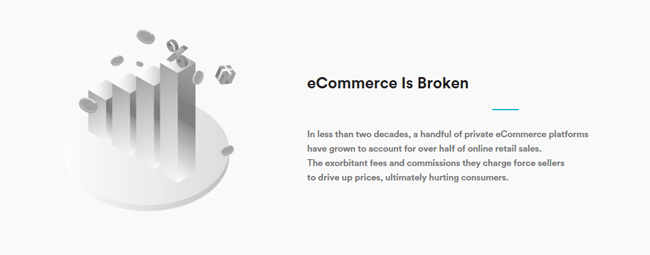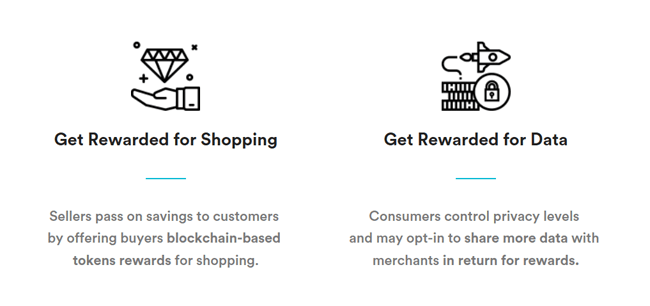There’s a new effort to move ecommerce to the blockchain, taking back the marketplace functionality in a decentralized environment that is of greater benefit to small merchants and customers alike. This is the Public Market Protocol, which will alleviate the need for private marketplaces, letting merchants engage directly with their customers, and ridding the entire process of the monopolistic corporations that have interfered in the process with unnecessary fees and commission.
In some ways it is similar to the centralized application Shopify, which allows anyone to create their own ecommerce marketplace. The decentralized nature will make publicmarket.io even better, allowing anyone to create marketplace applications on the blockchain. These storefronts will be robust and persistent and will allow consumers to purchase goods at lower prices, will include far better rewards programs, and will come without any compromise in security or convenience. Because this is a decentralized blockchain implementation, the Public Market Protocol will allow the network effect to encompass protections, rewards, and reputations without a centralized control.
Public Market Protocol Review: Overview
The stated goal of Publicmarket.io is to allow for the creation of online marketplaces which are both independent and interoperable, through the use of shared standards, services and smart contracts. It will act to decentralize ecommerce and benefit merchants as well as customers, who will be rewarded for participating in the ecosystem. Merchants will see improved margins as the Public Market Protocol removes restrictions on discounts and price flexibility.
The architecture of the Public Market Protocol includes four microservices that are being decentralized on the blockchain, but which have traditionally been held as proprietary services, thus making commerce more costly than it needs to be. These four services are described in more detail below:
Public Inventory
In private marketplaces the inventory data architecture remains closed and private, but Publicmarket.io is seeking to replace that architecture with one that openly exposes data. It will make it transparent who is selling which products, what price they are charging, and will do so across the entire globe. The Public Inventory is in essence an open “database” that is accessible through a RESTful API, which will allow any person or group to create an online store and populate it with goods from the Public Inventory. There will be no need to concern themselves with holding and storing inventory or managing order fulfilment. Merchants will be able to sell whatever they wish to sell. This benefits the sellers as well, since their items can be listed on many more online sites, increasing their products exposure dramatically in some cases.
Public Catalogue
The Public Catalogue is another open database that will democratize access to product information. This will be a vast improvement over the current system that sees private retailers holding back this information in order to stifle competition. The Public Catalogue will be a platform for the publishing, consumption and management of the metadata relating to products from around the globe. Metadata is important since it gives essential information about a product in a standard manner. Think of the UPC codes on products or the ISBN classifications used for books. This would be similar, but would include so much additional information. For example, an television might have an image of the actual product, the name, manufacturer, model number, year manufactured, and all the features and technical specifications, all linked to the UPC.
Public Reputation
Public Reputation is planned to be very important to the platform, as it will provide a universal and portable trust system that holds performance information for sellers, no matter which marketplace they move to. This will allow merchants to change marketplaces but still maintain any trust they’ve already built up. This information will always be fully transparent and publically accessible. You might think of Public Reputation as a ranking score that changes as new reviews are posted to the blockchain. The reputation score is portable, and so it will follow a merchant onto any application built on the Public Market Protocol. Think of it as the Amazon review system, but not tied to Amazon. It would also show up on any other ecommerce site that uses the Publicmarket.io blockchain or related Dapps. Eventually additional information could be added, or buyer reputation could be added that shows the transaction history of the buyers, including cancellation, return or refund rates.
Public Protection
The fourth and final microservice will be Public Protection, which will serve to replace the centralized liability and protection for fraudulent transactions. This might provide one of the largest cost savings of all, since the centralized marketplaces, particularly the merchant account providers, assume liability for fraud, but pass the costs along to consumers in the form of high fees and commissions. In the case of the Public Market Protocol the individual merchants will not need to bear fraud risks. Instead, dispute resolution providers whose entire business is to ensure transactions will compete with each other to bear the risk and reward of insuring against “micro-fraud”, thus driving the cost of fraud protection for both buyers and sellers down.
Interoperability and Network Effects
In today’s ecommerce world you find disparate centralized platforms using versions of the Publicmarket.io protocol to attempt to build a network effect around their singular application. Amazon is no doubt the largest, and while the huge customer base has added to the amount of data available about merchants, and has dramatically increased the number of items available, it is also having a negative effect. That is the increasing costs associated with a centralized business model.
The Public Market Protocol is planning on using a different method to achieve the network effects. By allowing for interoperability between all the marketplace applications they will realize a set of shared resources. This will include an ever expanding set of goods, increased data points to rank and score reputations of merchants and eventually buyers, and increased competition to keep prices as low as possible.
One other network effect will be to capture an audience of loyal, engaged buyers for the Publicmarket.io based marketplaces. Because the network will be decentralized there will other developers tools that can be made available to improve the marketplaces, which is not possible with centralized ecommerce businesses. Finally, there is a the planned ability for marketplace applications to take advantage of the planned Patron (PTRN) token, which will be created to help incentivize and reward a variety of actions and behaviors across the network.
Tokenized Public Rewards – Patron (PTRN) Token
Once the Patron token is created it can be used as an incentive for many things, but one already planned is Public Rewards. This will allow marketplaces across the platform to offer their customers rewards. This can help some merchants who aren’t able to offer lower prices on goods, but still want a way to provide greater value for customers. It’s a way to overcome manufacturer pricing parity agreements that prevent sellers from discounting items. The Public Rewards will allow them to offer a rebate on an item without actually lowering the price or discounting the item. Public Rewards can also be used as a loyalty scheme, or even for something like encouraging the use of debit cards rather than credit cards (thus lowering processing fees).
The Public Rewards service is architected and implemented in the form of a Control API, a Rewards Distribution Service, and an Access-Audit service. This Control API is the master ledger that will track the debits and credits of token rewards in accounts. It can also act as an escrow service, securing tokens until any return or refund period has expired. This way there will be no risk of a user buying products to get PTRN reward tokens, only to later return the products while keeping the reward tokens. The Rewards Distribution service will sit between the blockchain, API and marketplaces using the Control API, working to distribute tokens appropriately. Finally, the Access-Audit service maintains access control between the Control API and Rewards Distribution service. It will also ensure the accuracy of master ledger operations, and will audit transactions made by the Distribution service.
Public Market Protocol Review: The Team

The Public Market project is being led by KJ Erickson, who is both the co-founder and CEO of the Public Market. KJ has 14 years experience as an entrepreneur, having been backed by top VCs including Greylock, Foundation Capital, Norwest, and Maveron. Her Y Combinator-backed company, Simbi, is the world’s largest services marketplace run on a digital currency.
The other co-founder and Chief Strategy Officer is Kanth Gopalpur, who has been involved in ecommerce since its inception in the 1990s. In 2002 he founded Monsoon Works and led the company through rapid, profitable growth with the company’s more than 1,000 customers processing $1 billion+ in online sales annually. Monsoon Works appeared on the Inc. 500 list for three straight years before it was sold to a private equity group in 2010.
In Conclusion
Publicmarket.io is an ambitious project, and even if it can realize the savings it claims, and implement the public global features, it could have a very hard time overcoming the entrenched traditional centralized marketplaces. Yes, it is an amazing opportunity and would benefit merchants and those operating online marketplaces. The question is will consumers trust the project enough to make the switch. That could take time, and with the centralized solutions working against the Public Market Protocol it could take even longer.
In any case it could be some time until we see even an alpha version of this platform, let alone a beta or main net version. As of June 2018 there’s no timeline, no whitepaper, no idea when an ICO will see a token released into the wild. In fact, other than the vision and mission there’s little I’ve found in the way of concrete progress. It’s a worthwhile project to be sure, but one I believe needs time to grow. Maybe in six months time we can check back in and see what progress has been made.


